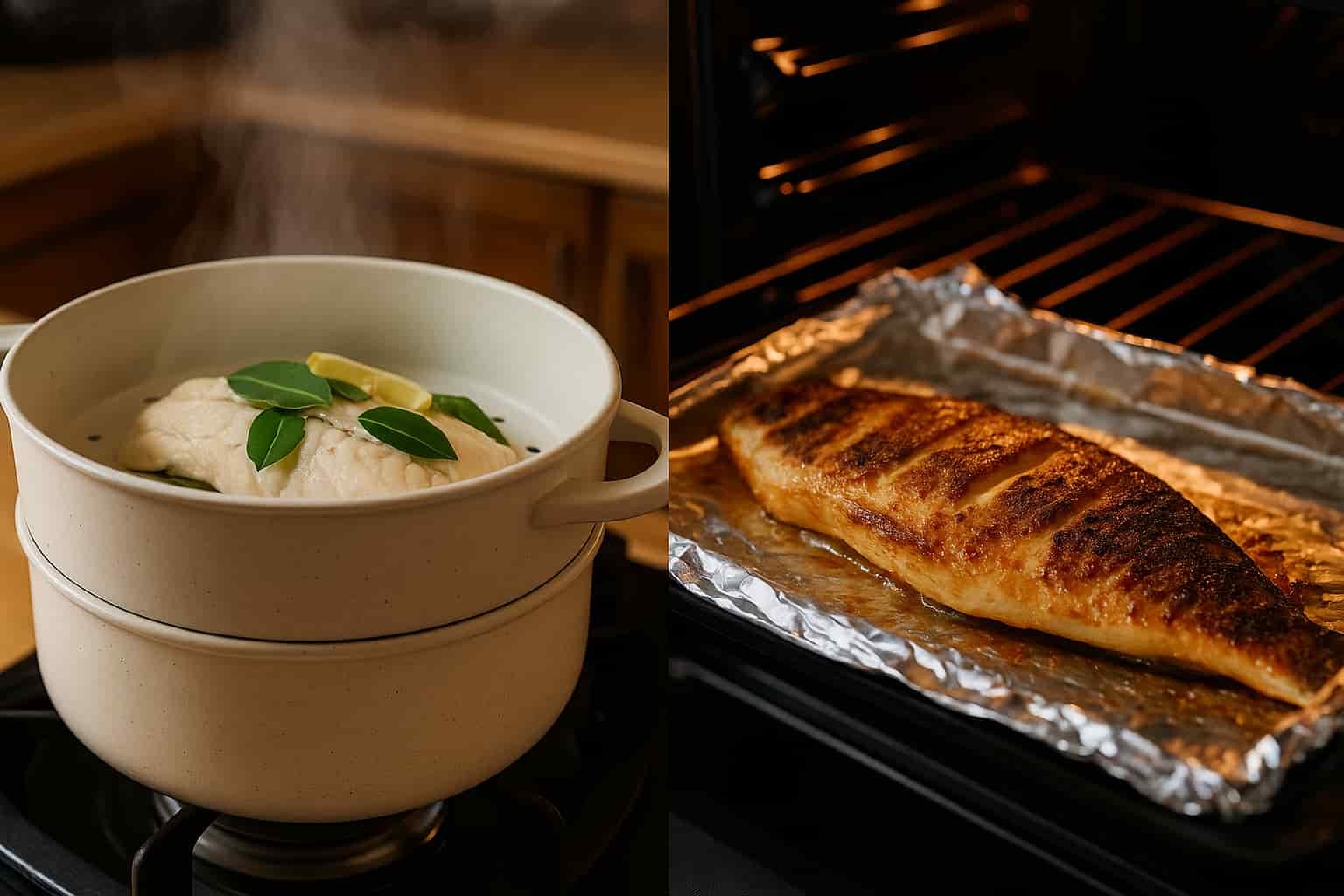When it comes to cooking seafood, choosing the right method can make all the difference in flavor, texture, and nutritional value. Two of the most popular techniques—steaming and baking—each offer unique benefits and outcomes. Whether you’re a health-conscious home cook or simply want to bring out the best in your seafood, understanding the pros and cons of these cooking styles is essential.
In this article, we’ll explore the differences between steamed and baked seafood, comparing them across several key areas: health benefits, taste and texture, and cooking convenience. By the end, you’ll have a clearer idea of which method suits your lifestyle and taste preferences best.
Contents
- 1 Health Comparison: Which Is Healthier?
- 2 Taste and Texture Differences
- 3 Time and Convenience in the Kitchen
- 4 Nutrient Retention: What Do You Lose or Gain?
- 5 Best Seafood Choices for Steaming
- 6 Best Seafood Choices for Baking
- 7 Environmental and Equipment Considerations
- 8 Conclusion: Which One Is Right for You?
Health Comparison: Which Is Healthier?
One of the biggest factors people consider when cooking seafood is health. Both steaming and baking are regarded as healthy cooking methods, especially when compared to frying or grilling with excess fats. However, they differ in how they retain nutrients and affect the overall calorie content of your meal.
Steaming is often viewed as the healthiest option. It uses no added fats and cooks food through moist heat, which helps retain water-soluble vitamins like B-complex and vitamin C. This method also preserves the natural flavor of seafood, making it ideal for those following low-fat or low-cholesterol diets.
Baking, on the other hand, can be healthy depending on how it’s done. When baking seafood with minimal oil or using parchment paper or foil, the fat content remains low. However, certain baked recipes may involve butter, cream sauces, or cheese, which can increase calorie and fat levels. The upside is that baking can help enhance flavor through caramelization and the use of dry herbs or spices.
In short, steaming is generally better for pure, clean eating, while baking allows more flexibility in flavors at the potential cost of added calories—depending on the ingredients used.
Taste and Texture Differences
Flavor and mouthfeel are where steaming and baking take noticeably different paths. Each technique brings out unique characteristics in seafood that may influence your choice depending on the dish and your personal preferences.
Steamed seafood has a delicate, clean flavor that highlights the natural sweetness and brininess of the ocean. Because there’s no browning or crust development, the texture remains soft and moist. This makes steaming ideal for tender items like shrimp, clams, or white fish fillets, where overcooking can easily lead to a rubbery result.
In contrast, baked seafood often features a richer, more developed flavor due to the Maillard reaction—a chemical process that occurs when food is exposed to dry heat. Baking creates a slightly crisp exterior and firmer texture, particularly for fish with high oil content like salmon or mackerel. It also provides a great base for herbs, marinades, and glazes, which can deepen the complexity of the dish.
Ultimately, if you’re aiming for a light, refreshing seafood dish, steaming is your go-to. If you want bold, savory notes with a heartier finish, baking is the better bet.
Time and Convenience in the Kitchen
Aside from health and flavor, many home cooks consider how much time and effort a cooking method requires. Both steaming and baking are relatively simple, but each comes with its own level of convenience depending on your kitchen setup and experience level.
Steaming is typically quick and efficient. Once your pot or steamer is ready, most seafood cooks within 5 to 10 minutes. Cleanup is also minimal—no need to scrub baking trays or deal with burned-on sauces. However, steaming may require specific equipment such as a steamer basket or bamboo steamer, and it can be harder to cook large portions at once due to space limitations.
Baking, on the other hand, can take a little longer depending on the recipe and oven preheating time. Fish fillets may take 15–20 minutes to bake, and whole fish even longer. The upside is that ovens can handle larger quantities, making baking ideal for family meals or meal prep. With the use of foil or parchment paper, cleanup can also be fairly easy.
In terms of convenience, steaming wins for speed and simplicity, while baking offers versatility and is better suited for batch cooking.
Nutrient Retention: What Do You Lose or Gain?
Nutritional value is a key consideration, especially for those who eat seafood to boost their intake of omega-3 fatty acids, lean protein, and essential vitamins and minerals. Different cooking methods can affect how much of these nutrients remain in your food.
Steaming is excellent for preserving nutrients—particularly water-soluble vitamins such as vitamin B12, folate, and vitamin C. Because it avoids direct contact with high heat or cooking fats, there is minimal nutrient loss. Steamed seafood is also less likely to form harmful compounds that can occur at high temperatures.
Baking, while still a healthy option, can lead to the breakdown of heat-sensitive vitamins if cooked for too long or at very high temperatures. However, it does not significantly affect protein content or omega-3 fatty acids, making it a great method for preserving seafood’s heart-healthy benefits. Additionally, baking with antioxidant-rich ingredients like lemon, garlic, or herbs can enhance the overall nutritional profile.
So, while steaming retains more delicate nutrients, baking still holds its own—especially when executed with care and mindful ingredient choices.
Best Seafood Choices for Steaming
Not all seafood is created equal when it comes to cooking methods. Certain types of fish and shellfish are especially well-suited to steaming due to their delicate texture and subtle flavors.
The best candidates for steaming include:
- White fish fillets such as cod, haddock, or tilapia, which become tender and flaky without falling apart.
- Shellfish like mussels, clams, and scallops, which open naturally and cook evenly in the moist heat.
- Shrimp and prawns, which cook quickly and maintain their juiciness and sweetness.
- Crab and lobster, which benefit from gentle steaming to keep their meat succulent and tender.
To enhance the flavor of steamed seafood, you can add aromatics like ginger, lemongrass, or citrus slices to the steaming water. This infuses the dish without overpowering the seafood’s natural taste. It’s also important not to overcrowd the steamer and to monitor cooking time carefully, as over-steaming can result in rubbery textures.
Steaming is especially ideal for those seeking a light, clean, and health-focused approach to seafood.
Best Seafood Choices for Baking
Baking is a fantastic method for a wide variety of seafood, especially for those who enjoy bold flavors, crispy textures, and the use of seasonings, marinades, or sauces. Unlike steaming, which favors delicacy, baking works well with heartier and oil-rich seafood varieties.
Here are some of the best types of seafood to bake:
- Salmon: Its high fat content helps it stay moist during baking, and it pairs well with everything from garlic butter to teriyaki glaze.
- Tuna and swordfish steaks: These meaty cuts benefit from the dry heat, developing a firm texture and rich taste.
- Mahi-mahi, halibut, and snapper: These thicker white fish hold up well in the oven and absorb marinades beautifully.
- Crab cakes and stuffed shellfish: Baking is ideal for evenly cooking and browning these more complex preparations.
Baking also allows room for creativity—think panko-crusted fillets, herb-encrusted sides, or foil-packet seafood with vegetables and lemon. To prevent dryness, consider using olive oil, broth, or foil covers, and always monitor cooking time to avoid overbaking.
For those who like versatility and depth of flavor, baking offers endless opportunities to turn a simple seafood dish into something truly satisfying.
Environmental and Equipment Considerations
When choosing between steaming and baking, it’s worth thinking beyond just taste and nutrition. Your kitchen setup, energy use, and equipment can also influence which method is more practical or sustainable for your lifestyle.
Steaming generally requires less energy, especially if you’re using a stovetop steamer that heats up quickly. It also doesn’t require any electricity if you’re using traditional bamboo steamers. However, steaming is often limited by size—you may need to cook in small batches unless you have a large steamer setup.
Baking, while more flexible in terms of quantity, usually involves preheating an oven, which consumes more energy. Additionally, ovens can heat the entire kitchen, which may be less desirable in warmer climates. However, if you’re baking other items alongside your seafood—like vegetables or grains—it can be a very efficient option.
In terms of equipment, steaming is generally more minimalistic, while baking requires an oven, trays, and sometimes special tools like thermometers or parchment paper. Your choice may come down to kitchen space, cooking habits, and environmental priorities.
Conclusion: Which One Is Right for You?
Both steaming and baking offer valuable advantages when it comes to cooking seafood—there’s no one-size-fits-all answer. The right choice depends on your goals, preferences, and lifestyle.
If you’re focused on health, clean flavors, and quick preparation, steaming may be your go-to method. It’s especially ideal for delicate seafood and those looking to reduce added fats or calories.
If you prefer richer tastes, crispy textures, and flexibility in flavors, baking is the better option. It allows more creativity with seasonings and is better suited for cooking in larger quantities or for special occasions.
Ultimately, there’s no need to choose just one. By understanding the strengths of each method, you can match your cooking technique to the seafood—and the meal—you have in mind.



